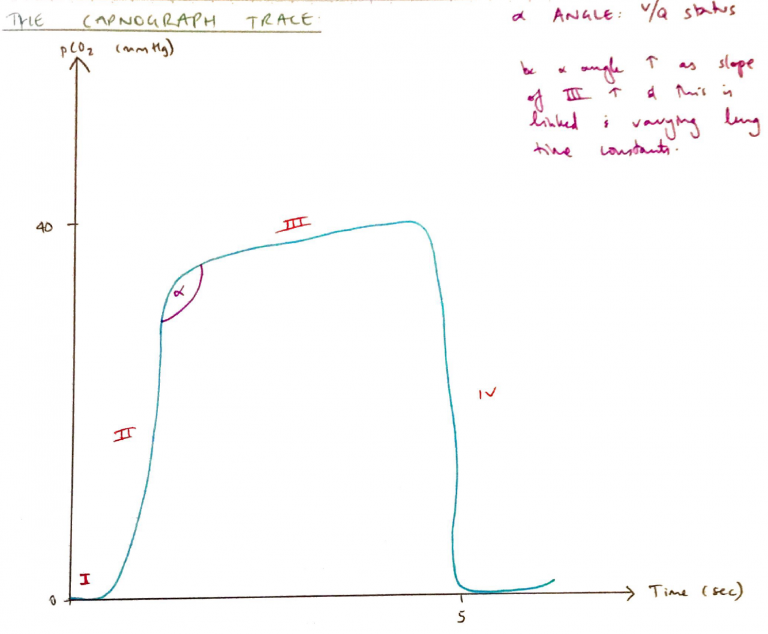F12ii / 23A03 / 19B10 / 15B09: Describe the principles of of capnography, including calibration, sources of error and limitations
23A03: Exam Report
Outline the principles of measurement of end-tidal CO2 using infrared radiation (25% of Marks). Describe the potential sources of error when using this modality and how they may be mitigated (75% of Marks)
21% of candidates passed this question.
The principles of infrared (IR) measurement of expired CO2 was answered in acceptable detail by most candidates. Sources of error were rarely identified nor explained in acceptable detail. Many candidates demonstrated errors of understanding when attempting to answer this section.
Important concepts not covered by numerous candidates included side-stream vs mainstream techniques; how the Beer-Lambert law is applied and how concentration is used for partial pressure; what is the role of sapphire glass and the difference between collision broadening and additional IR absorption by N2O.
19B10: Exam Report
Describe the principles of capnography, including calibration, sources of error and limitations.
31% of candidates passed this question.
Answers that scored well followed the structure outlined in the question and explained the principles of each component of the question.
15B09: Exam Report
Describe the principles of measurement of end-tidal CO2, including the sources of error.
19% of candidates passed this question.
Candidates were expected to be detail the principles required to measure carbon dioxide in expired gas. This would involve some comment on ways to sample end tidal gas (in line vs side stream) and also ways to measure carbon dioxide. It was expected candidates could provide a detailed description of infrared analysis including the apparatus design and principles such as the asymmetric nature of CO2 as a polyatomic gas allowing absorption if infrared radiation with some discussion of response times and equipment design. It was expected these principles would be related to the potential errors (e.g. other gases, collision broadening).
F12ii / 23A03 / 19B10 / 15B09: Describe the principles of of capnography, including calibration, sources of error and limitations
Methods to Measure CO2 in Gas Phase
- Infrared absorption
- Raman scattering
- Photoacoustic spectroscopy
- Mass spectroscopy
- Chemical analysis
CAPNOGRAPHY = continuous measurement & photo display of CO2 concentration in the airway, giving us the end tidal partial P of CO2
- Requires breath-by-breath analysis
- Rapid response time
- Accurate assessment from small sample
- IR most commonly used, but all can be used except chemical analysis (not quick enough)
ETCO2 < PACO2: normally lower than PaCO2 2 – 5mmHg due to alveolar CO2 dilution with dead space gas, which has no CO2
PACO2 < PaCO2: because blood from unventilated alveoli mixes with blood from ventilated alveoli
Sampling
2 methods of anaesthetic gas sampling
Infrared Analysis
- Radiation shines from infrared source (hot wire)
- Emitted radiation passes through a filter which allows only 1 wavelength to pass (i.e. filter set to desired frequency)
- Sample chamber & reference chamber
- Made out of sapphire, as glass absorbs IR
- Sample chamber → CO2 absorbs IR at 4.3µm wavelength
- Reference chamber → CO2 free, allows zeroing & comparison
- Electronics calculates the difference in absorption b/w 2 chambers → converts to a number of partial pressure & displays as a graph vs. time
Principle
- Gases ≥ 2 atoms absorb IR
- This allows their calculation in a sample
- By Beer-Lambert’s Law, amount of IR absorbed is proportional to gas [ ]
- ∴high gas [ ] absorbs more IR & less IR light is detected
Error
Collision Broadening
- When CO2 absorbs IR, it ↑the vibration/rotational E
- In presence of N2O, some of this E is transferred to N2O when both collide
- Allows CO2 to absorb more IR
- Broadens the absorption spectrum of N2O
- ↑measured CO21% & ↑N2O 10%
Sampling
- Atmospheric gas leak → into side stream, underestimates
- Blocked line → loss of sampling
- Water condensation → absorbs IR light → overestimates
Calibration Issue = incorrect analysis
The Capnograph Trace
- I: Dead space
Patient breathes out first the anatomical DS which has no CO2
- II: Mixture of anatomical DS & alveolar gas
CO2 [ ] rises
- III: Alveolar plateau
All alveolar gas → positive upslope since CO2 continuously excreted into alveoli
- IV: Inspiratory phase
CO2 falls to zero as fresh gas inhaled
- Author: Krisoula Zahariou


